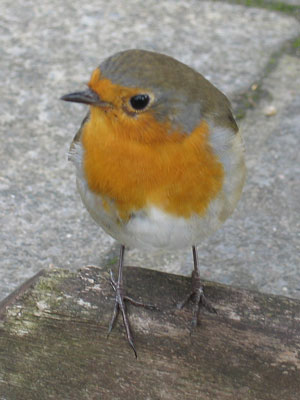ROBIN
So, you would like to see more robins in your garden, yes? Well, there are a few important do's and don'ts to consider. Firstly it's always a good idea to provide the kinds of things that we're looking for. When you think of the needs of any bird, it all reduces down to just two basic requirements: 1) a reliable source of food and 2) somewhere safe to build a nest and raise a family.
Addressing the necessity for food to begin with: you should provide the things that we find the most nutritious and tasty. In the wild we eat worms and insects during the spring and summer, with a variety of berries and fruits added in the autumn and winter. So firstly, if you have a plot or garden area of any kind, make sure it has plenty of natural areas of bushy undergrowth; dense and slightly uncultivated places so as to attract plenty of living prey - spiders, caterpillars and worms of all kinds

Next, you can add some more refined treats, like mealworms or sunflower seeds, available from shops or online. Also put out some balls of suet or fat, which can be hung from feeding stations or bird tables or, even better, placed somewhere discrete. A favourite location would be a log feeder - some holes in an old log that can be stuffed with all kinds of goodies.
Redbreasts aren't really too bothered about fancy bird tables or feeding stations since they invariably draw in lots of other birds, many of which are much bigger and aggressive and some of which will also feed on our eggs during the nesting season - which brings us to the next big requirement for your typical garden robin, a useful place to build a nest and raise their young.
We always need somewhere safe to nest in the spring. Bramble or juniper bushes are very suitable, for example, since they are dense and prickly and keep out predators such as cats or foxes, as well as some of the larger birds that might feed on our eggs. But a well-positioned bird box is also a much-favoured option. It should be of the open-fronted variety, and placed out of direct sunlight or strong winds. Ideally it will also be shrouded and hidden by some form of foliage - ivy or honeysuckle, for instance. That keeps the growing family suitably hidden and safe.
Those are the things you should be considering. But what about those you should avoid? Well, for a start, please keep an eye on your cat and try to discourage it from preying on birds. Robins won't fancy places that have cats on the prowl 24/7 and will tend to avoid them. Also resist the temptation to go in for too many areas of paving or decking. These don't support wildlife hardly at all, and there is therefore little there for birds of any kind to feed on. Lawns are far preferable, as are flower beds and shrubbery with lots of natural living things crawling about for robins to forage after.
That's it. Put these ideas into practice and you should make great strides towards transforming your garden space into a robin-friendly haven. Meanwhile, all these tips and many more, can be found it this excellent publication ...